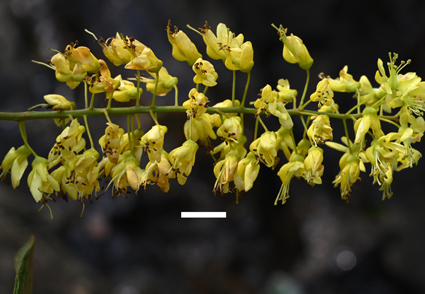Abstract
A new species, Ticanto xylocarpa K. W. Jiang & Shi J. Li is described and illustrated here. It is superficially similar to T. magnifoliolata in its leaf shape and ferruginous young branches and inflorescence axes. However, it is readily distinguished by the ligneous and wingless pods that are dehiscent when mature. Calculations of Area of Occupancy (AOO) and Extent of Occurrence (EOO) suggest that Ticanto xylocarpa meets the criteria for Least Concern (LC) in the IUCN Red List.
References
- Adanson, M. (1763) Familles des plantes 2. Vincent, Paris, 640 pp.
- Aiton, W.T. (1811) Hortus Kewensis 3. Longman, Hurst, Rees, Orme, and Brown, London, 432 pp.
- Bachman, S., Moat, J., Hill, A.W., de la Torre, J & Scott, B. (2011) Supporting Red List threat assessments with GeoCAT: geospatial conservation assessment tool. ZooKeys 150: 117–126. https://doi.org/10.3897/zookeys.150.2109
- Bentham, G. (1852) Florula Hongkongensis: an enumeration of the plants collected in the Island of Hong-Kong, by Major J. G. Champion, 95th Reg., the determinations revised and new species described. Hooker’s Journal of Botany and Kew Garden Miscellany 4: 73–81.
- Bentham, G. (1865) Leguminosae. In: Bentham, G. & Hooker, J.D. (Eds.) Genera Plantarum 1. A. Black, Londini, pp. 434–600.
- Bruneau, A., Mercure, M., Lewis, G.P. & Herendeen, P.S. (2008) Phylogenetic patterns and diversification in the caesalpinioid legumes. Botany 86: 697–718. https://doi.org/10.1139/B08-058
- Clark, R.P. (2016) A taxonomic revision of Mezoneuron (Leguminosae: Caesalpinioideae: Caesalpinieae). Phytotaxa 274 (1): 1–72. http://dx.doi.org/10.11646/phytotaxa.274.1.1
- Clark, R.P., Jiang, K.-W. & Gagnon, E. (2022) Reinstatement of Ticanto (Leguminosae-Caesalpinioideae) – the final piece in the Caesalpinia group puzzle. PhytoKeys 205: 59–98. https://doi.org/10.3897/phytokeys.205.82300
- Craib, W.G. (1914) Leguminosae. In: Sargent, C.S. (Ed.) Plantae Wilsonianae 2. The University Press, Cambridge, pp. 87–119.
- De Candolle, A.P. (1825) Prodromus systematis naturalis regni vegetabilis 2. Sumptibus Sociorum Treuttel et Würtz, Parisii, 644 pp.
- De Lamarck, M. le (1785) Encyclopédie méthodique (Botanique) 1. Panckoucke, Paris & Plomteux, Liège, 752 pp.
- Gagnon, E., Lewis, G.P., Sotuyo, J.S., Hughes, C.E. & Bruneau, A. (2013) A molecular phylogeny of Caesalpinia sensu lato: Increased sampling reveals new insights and more genera than expected. South African Journal of Botany 89: 111–127. https://doi.org/10.1016/j.sajb.2013.07.027
- Gagnon, E., Hughes, C.E., Lewis, G.P. & Bruneau, A. (2015) A new cryptic species in a new cryptic genus in the Caesalpinia group (Leguminosae) from the seasonally dry inter-Andean valleys of South America. Taxon 64 (3): 468–490. http://dx.doi.org/10.12705/643.6
- Gagnon, E., Lewis, G.P., Hughes, C.E., de Queiroz, L.P. & Lewis, G.P. (2016) A new generic system for the pantropical Caesalpinia group (Leguminosae). PhytoKeys 71: 1–160. https://doi.org/10.3897/phytokeys.71.9203
- Gagnon, E., Clark, R.P., Ringelberg, J.J. & Lewis, G.P. (2024) Tribe Caesalpinieae. In: Bruneau, A., de Queiroz, L.P. & Ringelberg, J.J. (Eds.) Advances in Legume Systematics 14. Classification of Caesalpinioideae. Part 2: Higher-level classification. PhytoKeys 240: 103–105. https://doi.org/10.3897/phytokeys.240.101716
- Handel-Mazzetti, H. (1936) Kleine beiträge zur kenntnis der flora von China V. Österreichische Botanische Zeitschrift 85 (3): 213–228. https://doi.org/10.1007/BF01255464
- Hemsley, W.B. (1887) Leguminosæ: Cæsalpineæ. The Journal of the Linnean Society (Botany) 23: 204–214.
- IUCN Standards and Petitions Subcommittee (2022) Guidelines for using the IUCN Red List categories and criteria. Version 15. Available from: https://nc.iucnredlist.org/documents/RedListGuidelines.pdf (accessed 24 December 2023)
- Lewis, G.P. (2005) Tribe Caesalpinieae. In: Lewis, G., Schrire, B., Mackinder, B. & Lock, M. (Eds.) Legumes of the world. Royal Botanic Gardens, Kew, pp. 127–159.
- Lewis, G.P. & Schrire, B. (1995) A reappraisal of the Caesalpinia group (Caesalpinioideae: Caesalpinieae) using phylogenetic analysis. In: Crisp, M.D. & Doyle, J.J. (Eds.) Advances in Legume Systematics, Part 7: Phylogeny. Royal Botanic Gardens, Kew. pp. 41–52.
- Li, S., Chen, Z. & Zhang, D. (2002) Caesalpinia elliptifolia (Leguminosae: Caesalpinioideae): a new species from China. Nordic Journal of Botany 22 (3): 349–352. https://doi.org/10.1111/j.1756-1051.2002.tb01383.x
- Li, S., Zhang, D. & Chen, Z. (2006) A new species of Caesalpinia (Leguminosae, Caesalpinioideae) from China. Novon 16: 78–80. https://doi.org/10.3417/1055-3177(2006)16[78:ANSOCL]2.0.CO;2
- Linnaeus, C. (1753) Species plantarum 1. Laurentius Salvius, Stockholm, pp. 1–560.
- Linnaeus, C. (1762) Species plantarum (ed. 2) 1. Impensis Direct. Laurentii Salvii, Holmiae, 784 pp.
- Manzanilla, V. & Bruneau, A. (2012) Phylogeny reconstruction in the Caesalpinieae grade (Leguminosae) based on duplicated copies of the sucrose synthase gene and plastid markers. Molecular Phylogenetics and Evolution 65: 149–162. https://doi.org/10.1016/j.ympev.2012.05.035
- Metcalf, F.P. (1940) Eight new species of Leguminosae from Southeastern China. Lingnan Science Journal 19: 549–563.
- Molinari-Novoa, E.A. & Sanchez Ocharan, C. (2016) Notulae nomenclaturales I. Transfers to Tara. Weberbauerella 1 (8): 1–6.
- Molinari-Novoa, E.A., Mayta Anco, L.F. & Sanchez Ocharan, C. (2016) Notulae nomenclaturales IV. Transfers to Biancaea. Weberbauerella 1 (11): 1–3.
- Nores, J.M., Simpson, B.B., Hick, P., Anton, A.M. & Fortunato, R.H. (2012) The phylogenetic relationships of four monospecific caesalpinioids (Leguminosae) endemic to southern South America. Taxon 61: 790–802. https://doi.org/10.1002/tax.614006
- Prain, D. (1908) A new species of Butea, with notes on the genus. Bulletin of Miscellaneous Information (Royal Botanic Gardens, Kew) 1908 (9): 381–387. https://doi.org/10.2307/4113214
- Reinchenbach, H.G.L. (1832) Flora Germanica Excursoria 2. Carolum Cnobloch, Lipsiae, pp. 435–478.
- Roxburgh, W. (1814) Hortus Bengalensis. Serampore, 300 pp.
- Simpson, B.B. & Miao, B.M. (1997) The circumscription of Hoffmannseggia (Fabaceae, Caesalpinioideae, Caesalpinieae) and its allies using morphological and cpDNA restriction site data. Plant Systematics and Evolution 205: 157–178. https://doi.org/10.1007/BF01464402
- Simpson, B.B., Larkin, L. & Weeks, A. (2003) Progress towards resolving the relationships of the Caesalpinia group (Caesalpinieae: Caesalpinioideae: Leguminosae). In: Klitgaard, B.B. & Bruneau, A. (Eds.) Advances in Legume Systematics, Part 10: Higher Level Systematics. Royal Botanic Gardens, Kew, pp. 124–148.
- Vidal, J.E. & Hul Thol, S. (1976a) Révision des Caesalpinia asiatiques. Bulletin du Muséum National d’histoire naturelle Sér. 3: 69–136.
- Vidal, J.E. & Hul Thol, S. (1976b) Césalpiniacées Asiatiques nouvelles. Adansonia 15 (3): 391–396.
- Wight, R. & Arnott, G.A.W. (1834) Prodromus floræ Peninsulæ Orientalis 1. Parbury, Allen, & Co., London, 480 pp.


